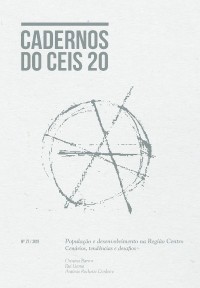Please use this identifier to cite or link to this item:
https://hdl.handle.net/10316.2/47442| DC Field | Value | Language |
|---|---|---|
| dc.contributor.author | Barros, Cristina | por |
| dc.contributor.author | Gama, Rui | por |
| dc.contributor.author | Cordeiro, António Rochette | por |
| dc.date.accessioned | 2019-10-15T11:35:06Z | |
| dc.date.accessioned | 2020-03-17T15:04:56Z | - |
| dc.date.available | 2019-10-15T11:35:06Z | |
| dc.date.available | 2020-03-17T15:04:56Z | - |
| dc.date.issued | 2019 | - |
| dc.identifier.isbn | 978-989-26-1801-2 | por |
| dc.identifier.isbn | 978-989-26-1802-9 (PDF) | por |
| dc.identifier.uri | https://hdl.handle.net/10316.2/47442 | por |
| dc.description.abstract | In recent decades, the successive decline in the number of births has characterised the Portuguese demography, while average life expectancy has increased, this being reflected in a demographic structure with an ageing population. There are fewer people, and they die later. This case is not manifested in the same way across the country, albeit the underlying trend is common to the various rural and urban territories. In terms of population structure, the fact that there are fewer children and school-aged young people does have its consequences, hence why human resource and equipment requirements in the education sector must be remodelled on a continuous basis to address this situation. Against this new demographic, economic and social context, the primary aim of research lies in understanding how the Central Region will evolve in the next two decades (2011-2031), giving some indicators and growth trends that allow us to characterise the future population of this territory. Discussions also cover the implications arising from the changes in the Portuguese population, in particular in the Central Region, addressing the demand for the education system, the training offer to be designed, and the required human resources, and how the different institutions and organisations will respond to an increasingly ageing population with different needs and requirements. | eng |
| dc.description.abstract | A demografia portuguesa caracteriza-se, nas décadas mais recentes, por uma sucessiva diminuição do número de nascimentos. Em paralelo, regista-se um prolongamento da esperança média de vida traduzida numa estrutura demográfica com uma população cada vez mais envelhecida. Sendo cada vez menos, morre-se cada vez mais tarde. Esta evolução tem uma tradução espacial desigual, mesmo sendo a tendência de fundo comum aos diferentes territórios, sejam rurais ou urbanos. Com consequências diversas, do ponto de vista da estrutura da população, são cada vez em menor número as crianças e os jovens em idade escolar. As necessidades de recursos humanos e de equipamentos no setor da educação têm, desta forma, que ser continuamente reestruturados para responder a este quadro. Tendo presente este novo contexto demográfico, económico e social, a investigação tem como objetivo fundamental compreender como será a evolução da população para a Região Centro nas próximas duas décadas (2011-2031), apresentando- se alguns indicadores e tendências evolutivas que permitem caraterizar a população futura deste território. Paralelamente discutem-se as implicações decorrentes das alterações na demografia portuguesa, e em particular na demografia da Região Centro, considerando a procura que o sistema educativo terá, a oferta formativa a desenhar e os recursos humanos que serão necessários, assim como as respostas que as diferentes instituições e organizações terão que dar a uma população cada vez mais envelhecida e com outras necessidades e exigências. | por |
| dc.format.extent | 70 p. | por |
| dc.language.iso | por | por |
| dc.publisher | Imprensa da Universidade de Coimbra | por |
| dc.rights | open access | por |
| dc.subject | Demography | eng |
| dc.subject | demographic projections | eng |
| dc.subject | School projections | eng |
| dc.subject | Central Region | eng |
| dc.subject | Demografia | por |
| dc.subject | Projeções demográficas | por |
| dc.subject | Projeções escolares | por |
| dc.subject | Região Centro | por |
| dc.title | Cadernos do CEIS 20 nº 27: População e desenvolvimento na Região Centro: cenários, tendências e desafios | por |
| dc.type | book | por |
| dc.identifier.doi | 10.14195/978-989-26-1802-9 | por |
| uc.publication.digCollection | PB | por |
| uc.publication.area | Artes e Humanidades | por |
| uc.publication.manifest | https://dl.uc.pt/json/iiif/10316.2/47442/153454/manifest?manifest=/json/iiif/10316.2/47442/153454/manifest | - |
| uc.publication.thumbnail | https://dl.uc.pt/retrieve/8468717 | - |
| uc.itemId | 55448 | - |
| item.grantfulltext | open | - |
| item.fulltext | With Fulltext | - |
| Appears in Collections: | Pombalina | |
Files in This Item:
| File | Description | Size | Format | |
|---|---|---|---|---|
| cadernos_populacao_e_desenvolvimento.pdf | 10.82 MB | Adobe PDF |  |
Items in DSpace are protected by copyright, with all rights reserved, unless otherwise indicated.
